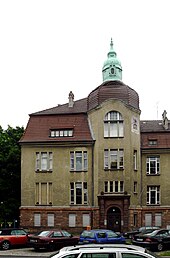Sugar Museum

The Sugar Museum in Berlin is the oldest museum of its kind, was opened on May 8, 1904 together with the then Institute for the Sugar Industry and has been part of the German Museum of Technology since 1995 . Until 2012 it was housed in the Institute for Food Technology building at Amrumer Straße 32 in Wedding and has since been closed due to its move to the German Museum of Technology in Berlin . Its presentation has been part of the permanent exhibition “Alles Zucker! Food - Material - Energy ”of the German Museum of Technology.
Historical background
Berlin is of particular importance for sugar production insofar as Franz Carl Achard , a Berlin physicist, experimented with various sugary native plants from 1780. Of the plants grown on his estate in Kaulsdorf near Berlin, the beet turned out to be the most productive. Achard was able to optimize them through further breeding and also significantly increase the yield through targeted fertilization. In 1799 he could King Friedrich Wilhelm III. present sugar from beets for the first time. With royal support, he finally set up the world's first beet sugar factory in 1801 on an estate in Kunern ( Silesia , see also Wińsko ) .
Themes of the permanent exhibition
After a year-long renovation, the Sugar Museum reopened at the end of 1989. A cultural-historical collection on the history of sugar is on display. The permanent exhibition , which is divided into seven subject areas, includes the natural and nutritional basics of sugar. Furthermore, the technical, cultural and political importance of sugar is examined.
The sugar cane

The first part of the exhibition deals with the history of the sugar cane plant . It describes how people learned to extract sugar from the sugar cane plant. The sugar was cleaned in increasingly complex processes until white sugar could then be produced for the first time. The exhibition shows machines for the production and cleaning of sugar, sugar cane plants and possible pests that can attack the sugar cane.
Colonial sugar
Since the climate in the Caribbean was favorable for the cultivation of sugar cane, the center of sugar production emerged there in the 16th century. Sugar was an important colonial commodity as a commodity in the 16th to 18th centuries . The exhibition describes the rise of important trading and refinery centers such as Antwerp , Amsterdam , Bordeaux , Hamburg and London and shows the ships usually used in transport as a model .
Slave economy
The great demand for sugar in Europe meant that more and more workers were required in the cultivation areas of the colonies. African slaves were increasingly used in the plantations . The exhibition gives an insight into the lives of the workers and shows the inhumane transport conditions that prevailed during the crossing from Africa to America .
Beet sugar in Prussia
The discovery of beet sugar turned what was once a luxury good into a mass product. The exhibition shows a model of a beet sugar factory in Silesia from 1801, which gives an impression of the work steps required for the industrial production of sugar. The model also shows the working and living conditions of the workers in such a factory. A large-format painting also shows a fictional encounter between Franz Carl Achard , the 'inventor' of beet sugar and the Prussian King Friedrich Wilhelm III. where Achard presented the first beet sugar to the king.
Sugar production

Increasing industrialization resulted in sugar becoming a staple food . The exhibition shows the areas in Germany in which sugar is mainly grown. It shows the breeding and technical innovations of the last 100 years, but also the economic and ecological importance of the by-products such as molasses and bagasse .
A world without sugar
The penultimate part of the permanent exhibition shows how many products contain sugar today. She describes the role of sugar as a supplier of energy and questions whether there is a connection between the consumption of sugar and tooth decay . This part also shows the conversion of grape sugar into sucrose within plants.
No alcohol without sugar
The section “No sugar, no alcohol” is located in the museum's winter garden. It shows how people discovered the intoxicating effects of alcohol many thousands of years ago . The exhibition also describes the process of producing alcohol with the help of sugar.
Head of the Sugar Museum
- 1972–1995: Hubert Olbrich
- 1995–2012: Bernhard E. Nickl (1950–2012)
literature
- Zucker-Museum - on the occasion of the reopening on September 22, 1989 , edited by Hubert Olbrich , Schriften aus dem Zucker-Museum, ISSN 0171-273X (catalog of the museum); 228 pp.
- Sugar Museum in the Berlin Sugar Institute . 1975, ed. by Hermann Dressler and Hubert Olbrich; 96 pp.
- Baedekers Allianz travel guide Berlin . Verlag Karl Baedeker GmbH, Ostfildern-Kemnat 1991, ISBN 3-87504-126-7 , p. 295.
- The chronicle of Berlin . Chronik Verlag, Dortmund 1986, ISBN 3-88379-082-6 , p. 139.
Movie
- The cutest museum in Berlin. The new sugar museum. TV report, Germany, 2015, 2:32 min., Script and direction: Wolfgang Albus, moderation: Gerald Meyer , production: rbb , editing: Theodor. Story (s) from the Mark , first broadcast: December 6, 2015 at rbb, summary by Theodor, ( memento from December 7, 2015 in the web archive archive.today ), online video by rbb.
See also
- Ciaotou Sugar Factory , Museum in Taiwan
Web links
- Sugar Museum in the German Museum of Technology
- Zucker-Museum - Information from TU Berlin ( Memento from August 24, 2007 in the Internet Archive )
Individual evidence
- ↑ a b leaflet from the Sugar Museum
- ^ German Museum of Technology: Weddinger roots. Permanent exhibition It's all sugar! - Site with historical information about the Sugar Museum.
Coordinates: 52 ° 29 ′ 55 " N , 13 ° 22 ′ 36.5" E


